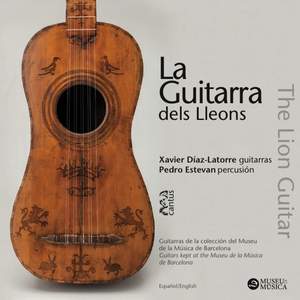One of the key moments in the history of this fascinating CD happened in 2010 when the Chief Curator of the Music Museum of Barcelona called on Xavier Díaz-Latorre to make a choice from among ten instruments that he had previously selected. Those chosen would be restored and then used in our recording. It was an impressive selection of 16th to 19th cen- tury guitars that had not been played in modern times, all of them in very good conditions, and every and all of them with interesting features that made them worth to be selected. After a long process involving the selection and restoration of the instruments, the choice of a repertoire, the study of the guitars, the recording and production of the CD, the task entrusted to him by the Museu de la Música de Barcelona has been, in Xavier Díaz-Latorre's own words, "one of the most fascinating experiences in my entire musical career".
What is offered here is not merely an example of the technical and musical possibilities of the instruments selected, but above all an amazing promenade through a music designed for a type of instruments that covered the aesthetic needs of their time, not ours. To get from them their full potential and maximize their marvelous features, making justice to them and to the music recorded here, one needs to approach them with curiosity and humility, accepting that in terms of interpreta- tion they can teach us important things, and allow us to explore aesthetics and sounds absolutely different to what today conforms our musical world and the way we perceive it.
It can be said that these instruments "confessed" Xavier Diaz-Latorre how he had to perform them, opening his senses to a musical world which was vibrantly different and exciting: delicate sonorities, nuanced colors, rediscovered thanks to the painstaking restoration done by the Museum team, and the use of gut strings by that wonderful performer, Xavier Díaz- Latorre, that allows us to experience the miraculous sound presented here.
The four guitars employed here are truly amazing instruments. Two of them come from the 17th century (one, The Lion Guitar, provides the title of the album, and other one is an Italian instrument of deeply suggestive sound), another from the early 19th century (a guitar made in 1806 by Josef Pagés incorporating construction methods appeared in those years), and finally the guitar made in Seville in 1859 by Antonio de Torres, considered the best guitar maker in history, and in which Díaz-Latorre recreates the music of Albéniz for the first time with a guitar of his time that sounds mysterious, full of contrasts, warm and disturbingly beautiful.
All of you are invited, then, to this fascinating journey through well-known pieces of the guitar repertoire that take new life and sound like they never sounded before thanks to a unique combination of elements: the interest of a great museum to give the best use to their collection, and that also has an excellent restoration team; the actual existence of a big number of wonderful instruments in their collections; and the musical curiosity of two world-class performers that once again work together and produce arresting performances that Cantus can now offer the world: Xavier Díaz-Latorre is the star of this CD dedicated to the guitar, and he seconded by Pedro Estevan, the legendary percussionist with whom he has been recording for so many years. An essential musical and sensorial experience that no serious collector and music lover can miss.



